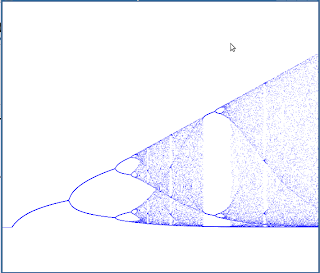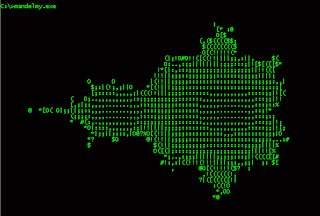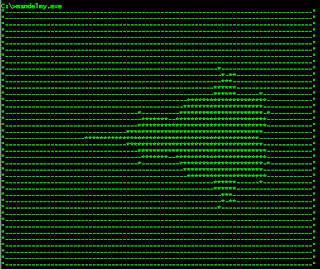martedì 29 dicembre 2009
Verlet integration in Haskell
Pubblicato da
koteth
2
commenti
![]()
giovedì 24 dicembre 2009
my delicious
Pubblicato da
koteth
1 commenti
![]()
martedì 8 dicembre 2009
Cairo-Chaos Haskell

Haskell chaos and lib-cairo.
Is only a fixed-point iteration over this function:
lgs x r = r * x * exp(- x )
Pubblicato da
koteth
0
commenti
![]()
Dollar $ operator in Haskell
Do you know what is $ operator in Haskell?
$ means simply , 'apply the left function at the right value'.
f $ x := f x
it seems really trivial, isn't it ?
But, for example in this kind of situation, is really usefull:
zipWith ( $ ) ( cycle [ \x -> div (x + 1) 2 , \x -> div x 2 ] ) [1..]
here you have a infinite list of function:
a = cycle [ \x -> div (x + 1) 2 , \x -> div x 2 ]
( ie: [\x -> div (x + 1) 2 , \x -> div x 2 , \x -> div (x + 1) 2 , \x -> div x 2, ... ] )
and you want to apply every element of the list at the element
at the same index in the second list:
b = [1..]
zipWith, for every index i takes the element a(i) of the left list
and b(i) of the right list and execute what is requested inside the parentheses.
In this situation is specified $ so:
a(i) $ b(i ) := a(i) ( b(i) )
the result must be the following:
[ 1 ,1 , 2, 2 , 3 ,3 ... and so on.
Pubblicato da
koteth
0
commenti
![]()
Prime Numbers in haskell
well, do you want to know how to find 'prime numbers' in a quick and dirty
way using Haskell ?
try this!
import Data.List
nubBy ( \x y -> mod y x == 0 ) [2..]
Haskell is so easy and charming...
( ps: if you want to speed up a little bit:
nubBy ( \x y -> ( x*x-1 <= y ) && ( mod y x == 0 ) ) [2..]
)
Pubblicato da
koteth
1 commenti
![]()
giovedì 20 agosto 2009
re: Mandelbrot Set in Haskell

Pubblicato da
koteth
0
commenti
![]()
Mandelbrot set in Haskell
gr = map(\y-> [( x:+y )|x<-[-3,-2.95..1]])[-2,-1.9..2]
main = mapM_ putStrLn ( (map(\el->show el) )image )

A first interpretation ( a little bit unsatisfactory ) of the Mandelbrot set in Haskell
Pubblicato da
koteth
0
commenti
![]()
martedì 18 agosto 2009
Numbers in Haskell
The core of numbers post in Haskell:
numList p x = map ( idens p x ) ( map ( x * ) [ 1..( p-1 ) ] )
matIde p = map ( numList p ) [ 1..(p-1) ]
Pubblicato da
koteth
0
commenti
![]()
domenica 16 agosto 2009
The Path of St. Augustine
Pubblicato da
koteth
0
commenti
![]()
Etichette: Il Cammino di Sant'Agostino, Italy, lombardia, The Path of St. Augustine
Dungeon ( Quinta da Regaleira - Portugal )
Quinta da Regaleira
( Mystic Cristina )
Pubblicato da
koteth
0
commenti
![]()
Etichette: image
domenica 19 luglio 2009
Mandelbrot in Rebol

And this is my interpretation of Mandelbrot fractal using Rebol:
Pubblicato da
koteth
0
commenti
![]()
domenica 12 luglio 2009
Latent Semantic Indexing ( LSI )
Pubblicato da
koteth
0
commenti
![]()
Etichette: data mining, text mining
sabato 11 luglio 2009
Peano in Js
Pubblicato da
koteth
0
commenti
![]()
Etichette: image, javascript, jquery
lunedì 6 luglio 2009
context-free art
A little piece of context-free art:
circles.cfdg
startshape trails background {b -1} rule trail { trail{ sat 0.001 a -0.001 r 0.4 y 0.5 s 0.999y 0.5 } SQUARE{s 1} } rule trail 0.001 { trail{flip 90} ring{x 5} } rule trails { 140*{r 120}trail{b 1 sat 0 h 100} } rule ring { 120*{r 5}SQUARE{s 4 0.5 y 6 h 100} }
Pubblicato da
koteth
0
commenti
![]()
Etichette: context-free, image
Rebol Search File
Another little Rebol program:
REBOL [Title: "Ricerca"]
mainWin: layout [
banner green "Ricerca Parola" box brick 580x2
text "Parola da cercare"
infi1: field infi2: field ""
text "nome file"
selFile: text-list data read %. [
infi2/data: value
infi2/text: value
show infi2
]
button "Ricerca" [
fil1: to-file infi2/data
text: read fil1
outOne: copy ""
while [ text: find text infi1/data ] [
formattedStuff: reduce [ " ( " index? text " ) " copy/part text 10 ]
append outOne "^/ ( indice ) riga: "
append outOne form formattedStuff
text: next text
]
tuno/text: form outOne show tuno
]
at 260x70
tuno: area 340x300 across
text "Risultato"
]
windowHelp: layout [
backcolor linen
h2 "Help Window"
text 300 { Inserisci la parola da ricercare e il nome del file...
}
button "Chiudimi" [ unview/only windowHelp ]
]
windowHelp/offset: mainWin/offset + (mainWin/size * 1x0) + 10x0
view/new mainWin
view/new windowHelp
do-events
Pubblicato da
koteth
2
commenti
![]()
'Text Categorization with SVM
A really nice pdf about 'Text Categorization with Support Vector Machines' ( from University of Dortmund ) :
http://www.cs.cornell.edu/People/tj/publications/joachims_97b.pdf
I'll try to post soon some code in Python about this problem...
Pubblicato da
koteth
0
commenti
![]()
Etichette: data mining, pdf, text mining
My first time in Rebol and numbers

Rebol is a fantastic language!
You can try this code in the Rebol/view Console:
numbers.r
REBOL [Title: "Numbers Test"]
ena: 121
positions: []
dimPal: 3
unitar: func [ ele enne ][ either (( (ele // enne) == 1 ) or (( ele // enne) == (enne - 1)))[ 1 ] ["-"] ]
evaluateUni: func [ en ] [
for j 1 en 1[ st: copy ""
for i 1 en 1[
append st unitar i * j en
sr: square-root en
if ( unitar i * j en ) == 1 [ append positions ( as-pair i j ) * 350 / en + 23x23 ]
]
]
positions
]
evaluateUni ena
refre: does[
positions: copy []
evaluateUni ena
pis: copy []
posi: copy positions
foreach p posi[ insert tail pis reduce[ 'fill-pen 160.209.215.100 'circle p dimPal ] ]
out: form ( length? positions ) / 2 == ( ena - 1 )
insert tail pis reduce [ 'text 230x5 join "numero primo: " out ]
scrn/effect/draw: copy []
append scrn/effect/draw pis
show scrn
]
refreNoEval: does[
pis: copy []
posi: copy positions
foreach p posi[ insert tail pis reduce[ 'fill-pen 160.209.215.100 'circle p dimPal ] ]
out: form ( length? positions ) / 2 == ( ena - 1 )
insert tail pis reduce [ 'text 230x5 join "numero primo: " out ]
scrn/effect/draw: copy []
append scrn/effect/draw pis
show scrn
]
lay: layout [
scrn: box 400x400 black effect [
draw [ text "unit" ]
rotate 50
gradmul 180.180.210 180.60.255
]
slider 200x16 ena / 300 [
ena: to-integer value * 300
inpNum/data: form ena
inpNum/text: form ena
show inpNum
refre
]
inpNum: field form ena [
print to-integer inpNum/text
ena: to-integer inpNum/text
]
at 330x460
btn "Change" [
refre
]
slider 100x15 dimPal / 10 [
dimPal: to-integer value * 10
refreNoEval
]
]
view lay
Pubblicato da
koteth
2
commenti
![]()




